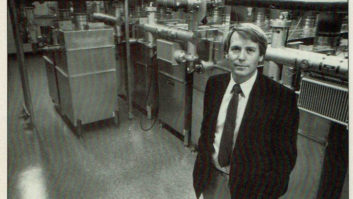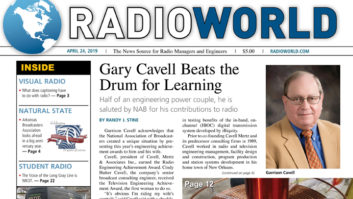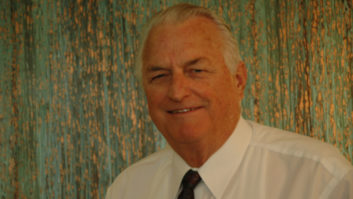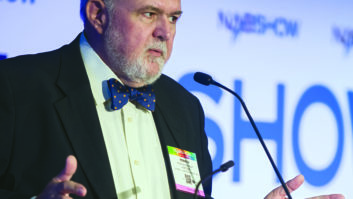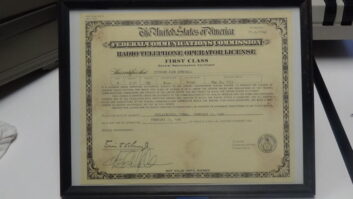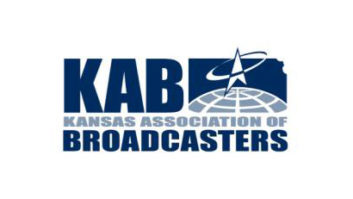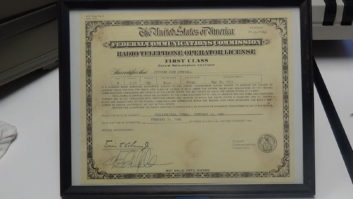Readers have shared memories of respected broadcast engineer Ron Rackley, who died April 12. Send your own remembrances and photos to [email protected].
Ron’s family also requests that photos and memories be shared via email to [email protected], and if you’d like to send cards or letters of condolence, mail them to:
du Treil, Lundin & Rackley, Inc.
Attn: Mrs. Dorothy Rackley
3135 Southgate Circle
Sarasota, FL 34239-5515
This article is periodically updated to reflect additional submissions.
Mario Hieb:
Yes, Ron Rackley was a giant.. He was a classically trained engineer who understood the RF world at great depth. Ron had a particular passion for AM radio systems and was well regarded for the many improvements he developed. We’ll miss you, Ron.
Geoff Mendenhall:
I am deeply saddened and shocked at the loss of my good friend, Ron Rackley.
Ron was the top expert in bandwidth optimization of AM broadcast antenna arrays for HD Radio and DRM transmission. I had the opportunity to work with Ron on several interesting broadcast engineering projects, and we both enjoyed our amateur radio antenna projects. He taught me so much over the decades that I knew him.
One of my favorite, fun memories of Ron was when we went together to Skycraft surplus electronic parts store in Winter Park, Fla., in search of ham radio goodies. We were like two kids in a candy store!
I am truly glad to have known and worked with Ron. He contributed so much to the broadcast engineering profession and is greatly missed.
Glynn Walden:
I am so saddened to learn of his passing as he was a friend and mentor. He always had time to explain and share his incredible knowledge, a two-line email from me led to a long multi-paragraph explanation of the problem or situation and his thoughts on solving it.
[Learn more about Rackley’s life and career.]
On Thursday of last week, he sent me a picture of the former AM site on Gomer Road where our first AM IBOC demonstration on KUSA took place. The picture that he sent shows that site is now a housing development. We talked on Thursday morning about our long nights at the site with Dave Hartup and Hilmer Swanson.
Ron lived his life as a Christian. I will miss the gentle giant and the broadcast industry will be less without him.
John Sadler, retired FCC Communications Specialist, writes:
It is hard to believe that the broadcast world has lost an industry icon. Ron was a real gentleman and a hard worker. He was a good friend of mine for over 50 years.
I first met Ron at one of the NAB engineering seminars on directional AM antennas in which we both participated. He was a very knowledgeable individual and always had time for everyone should they have questions relating to antennas.
During my 26 year tenure at the FCC, I had many opportunities to consult with Ron regarding reports that he had submitted to the FCC for review. My son Jim and his wife worked for the Rackley firm for several years, until the company relocated to Florida from Washington. Thanks to Jim’s experience with Ron’s firm, he still enjoys working in the industry at Carl T. Jones.
Ron will be sorely missed by those working in the broadcast business.
James Walker:
I had the honor and pleasure of working with Ron on a number of projects. He was always ready to talk about the philosophy behind the applications when there was time. I have found this to be the best way to learn a subject.
He was generous will all sorts of info. I had picked up a Wayne-Kerr b601 at the Dayton Hamfest. The unknown terminals are a bit complicated on that device. We were working on a new D.A. in Los Angeles, and I mentioned I had this bridge but no instructions. Ron talked at some length about that device and its virtues and weaknesses vis a vis devices such as the genrad 1606. A few weeks after I got back to my office in Cincinnati, a package arrived from Sarasota with a nicely bound copy of the Wayne-Kerr manual — with a note from Ron that said simply, “Hope this is useful.” (I still have the book with the note attached — and the bridge.)
For several years, I handled the network broadcasts of Cincinnati Reds’ spring training in Sarasota. I would invite Ron to lunch every year at his favorite local Mexican restaurant. Each of these occasions lasted for several hours as we just talked medium wave engineering. (He talked, I listened). These were fascinating experiences — some of the very best of my career — like going to an oracle.
Karl D. Lahm:
Superb engineer, raconteur par excellence, exemplary Christian. This was the Ron Rackley who I knew since 1981.
That summer, I joined Jules Cohen’s firm, experienced in transmitters, station engineering, and audio design, but a newbie to AM directional antenna design and tune-ups. Ron was the firm’s primary AM field engineer then. He didn’t mentor me in the conventional sense. Instead, he gave me hints here and there that greatly facilitated my own exploration of AM antenna theory and practical implementation, finding my own way. In turn, I created software that facilitated his work. We always approached engineering problems, especially field projects, very differently, but always with similar results. Ron was more intuitive and favored graphical analysis, I more deductive and favored numerical analysis. Many years later, we had the opportunity to work together again on a diplexing project, in 2017, which was an eminently enjoyable reunion.
That Ron was a character would be an understatement. On the door of his office in the Cohen firm’s suite, there was a business card that read “Ronald D. Rackley – All the Bull That’s Fit to Throw – Washington, DC”. He took me out for a drink the evening following my first son’s birth, firmly stating that “a man’s place during childbirth is in a bar.” He always had a good story, many involving less-than-optimal technical situations he had encountered over the years. And, anyone who new about it could never forget the night around 1990 that a pirate shortwave transmitter lit up and the voice said “Welcome to the voice of Trailer Park Ministries, America’s first pirate Christian radio station. This is the Rt. Rev. Dr. R.F. Field speakin’,” followed by a 40-minute parody of southern radio preachers from the ’80s.
Ron helped countless station engineers understand better how AM antenna systems worked. It seems that we lose too early those best equipped to transfer knowledge to our successors.
Jim Hawkins:
I am very saddened to hear of the loss of Ron Rackley. I met Ron for lunch in 2000 where he inspired me to further my studies of electromagnetic fields and radiation. He introduced me to the concept of displacement current and recommended that I start my studies in a book called “Radio-Electronic Transmission Fundamentals” by R. Whitfield Griffith, Jr. It is an honor to have known and met Ron and be inspired by him.
Ron was, in part, responsible for the republishing of this valuable book in 2000. He autographed and sent me a copy of the reprint, which I shall always cherish.
David E. Ehehalt:
I was just talking to him at Kurt’s Booth on Tuesday at NAB, John Lyons , Jim G , Kurt , Matt , Ben D + a few others, he was telling me, “You know Dave , I am pretty much retired now,” and I asked, “Don’t you think you will get bored?” “I still have enough to keep me busy.”
What will AM radio do without him?
I worked with him at WKDM in Carlstadt, N.J., as well as other locations. He gave me one of one of the greatest compliments I ever got from someone with his background and knowledge: “Hey Dave, I think you are starting to understand this. ” That statement coming from him , I thought I had just won an Emmy! I had been to his office in Sarasota , Fla. , as it was two to three blocks away from my good friend Gean’s Studio , five to six years ago, he had a great old AM radio collection that surrounded you on the upper shelf, all the old classics. He was one of (maybe the only?) few hams that ran CW from his mobile. This is a very large loss to the world of radio. I just can’t believe I was talking with him On Tuesday!
Richard Ross, chief engineer for Univision Radio in New York:
I have known Ron as far back as the 1980s. I cannot say enough great things about him. Here are only two anecdotes of many. Ron designed our WADO power increase from 5 kW to 50 kW which involved adding two towers.
As we were performing measurements (Ron and myself) at 2 a.m. one winter morning in December 1999, we experienced a vacuum cap failure in tower #3. Ron said we are not going to wait for a replacement and he sat down and drew it out of the ATU circuit which involved repositioning of coil taps and retuning of other caps among major retuning surgery in the system. By dawn we had a perfect in spec operating system.
Ron remembered what he and I had for lunch three years ago. I don’t remember what I had two days ago. We also owned 1989 Lincoln Town cars, and I still have mine.
Robert Martin, Entercom Greenville Spartanburg IT manager, engineering:
One of my favorite memories of Ron was one of my earliest in broadcasting. We were both very young members of the staff at WFBC AM/FM/TV in Greenville, S.C. In early 1973, he sat across from me at a small worktable in the primitive FM automation studio and tapped out 5 WPM Morse Code, so he could order the papers to administer my Amateur Radio Technician test. He was a special guy.
I am back working at the Entercom cluster in Upstate SC, and his handiwork is still all over our AM sites even today. I am proud to have known Ron and have some great memories of him!
Gary Liebisch:
Ron was one of my early mentors in Spartanburg, S.C., while he was with the late Palmer Greer. We were working on the WSPA phasor overnight and bleary-eyed. He asked me for an electric drill, and I pulled out one with the brand name Rockwell on it. Ron suddenly remarked, “Hey, that’s a Collins drill!”
Michael David Rey:
I’m saddened to learn we’ve all lost a true national treasure and friend of our industry.
Attached is the official sticker he placed on the KSPN 710 KinTronics phasor after blessing our newly rebuilt transmission system in 2009.
Ron was also instrumental in making the KTNQ 1020 rebuild an operational success in 1991 with the famous overhead ground system buried in the concrete walls and foundation of Towers Industrial Park in City of Industry, Calif., as well as consulting us on diplexing with KXTA-1150 (ex-KIIS-AM) in 1998.
During those rare ‘down times’, he’d share stories with the staff about the glory days of border radio.
R.I.P. Ron. You will be missed.
Garrett G. Lysiak:
I first met Ron when I was the engineer-in-charge of the St. Paul, Minn., office in 1981. After leaving the FCC and starting my own firm, we often talked about AM projects.
We often spoke about the future of AM Radio and the lack of new engineers entering the profession and how we could generate interest in younger folks.
He was a talented engineer, and I will miss him greatly.
73s, Ron.
Fred Greaves:
The broadcast industry has lost a friend and AM icon, its been said before, but I’ll say it again: He will be missed.
Ron taught me a lot about directional AM antennas and for that I am forever grateful.
Ron had a quiet sense of humor, I remember when we were working on the new directional system at WQBA in Miami, we would get back to the hotel early in the morning and the ice machine was always empty. Ron took out a 3 X 5 card and neatly wrote “Please do not urinate in the ice machine” he taped it to the machine, and quietly said
“We’ll have ice tomorrow night”. When we got back to the hotel the following night, the ice machine was completely full.
I would like to express my sincere condolences to Ron’s family and all of his friends of which there are many.
Bruce Hunter:
I have fond memories of Ron from my days of association with the Broadcast Technology Society and reading about his many accomplishments since.
A lasting memory arises from a luncheon one day when Ron mentioned how he had suffered from poor eyesight as a youth (perhaps nearsightedness, although he did not specifically say so). This forced him to mentally visualize his surroundings. Later, while studying vector calculus in college, he found this shortcoming turned out to be an asset as he could easily visualize the concepts of curl and other vector functions essential to the study of electromagnetics, while his classmates struggled.
In leaving us, Ron joins Carl Smith and other legendary engineers as an exceptional contributor to broadcast technology.
Paul Whitney:
I first met Ron Rackley in 1984. Over the years, it was my pleasure to work with him on numerous projects. Always a gentleman, he shared his knowledge and expertise freely, and for that I am grateful. He will be missed by all who knew him.
Burt Weiner:
I, too, am deeply saddened by Ron’s passing. What can I add that hasn’t already been expressed by so many?
Ron was a friend to all of us. He had a unique way of teaching us as he worked on our projects and at the same time giving us the grand feeling that each and every one of us was very important to him.
Ron taught me a great deal about directional AM Antenna theory, as well as the practical aspects of troubleshooting antenna systems. He made complex things seem so simple. I was always very flattered when he would call on me to go make measurements for him or to help out on a project.
Ron will be remembered for many things, but one of the things I will remember him most for was his Teddy bear-like nature. Thank you, Ron. ’Til we meet again.
Tom McGinley:
To be sure, the world has lost perhaps the very finest AM antenna system expert ever known.
Virtually everyone in the industry knew of Ron Rackley and his contributions to the art and science of AM directional antennas. If you were very lucky, you had the opportunity to meet and know Ron personally and work with him on one or more of perhaps thousands of projects he directed or became involved with just for the love of it.
I was fortunate enough to meet Ron in 1984 soon after moving to DC and became involved in numerous AM DA system repair and construction projects. He was immediately eager to help me and answer all the questions I had, completely gratis. He even shared with me a number of DOS programs he used to solve antenna design problems including MiniNec-3 in DOS, running on a 386 PC at the time. I still use those programs to this day.
We enjoyed many lunches together, along with others in the DLR firm, usually at Asian restaurants near their office. I always marveled at Ron’s ability to consume large amounts of extra hot mustard sauce mixed in with everything on his plate. When he finished, I was afraid smoke would start rising and he might catch fire. He always seemed to enjoy it immensely.
In the mid 1990s, Ron, Bob and John invited me to Sarasota, Fla., to discuss the possibility of being hired by the firm as a field engineer. I would have taken the job, but the wife just didn’t like the heat, the bugs and all the old people in Florida. We stayed with CBS Radio in D.C. and then a few years later transferred to Seattle.
I recall discussing with Ron the need for antenna monitor filters for the 1090/770 50 kW three-tower diplex in Seattle about 10 years ago. The cost of the internal filters for the new monitor designed and installed by the manufacturer was prohibitive. Ron grabbed a paper napkin at our lunch table and proceeded to draw up a set of external pass reject filters we could build up ourselves. He even supplied the approximate component values for each L&C right out of his brilliant organic calculator. We built up the three boxes using mostly eBay parts and Steve Lockwood did the precise tuning needed at H&D.
We saw Ron at NAB Show, as we had every year for many many previous years and chatted a bit about the current state of affairs for AM radio in general. I could tell he was a bit depressed about it and not pleased with declining station values with so many selling off real estate and going dark. He seemed to think the all-digital mode should eventually save the band and the larger stations with good coverage would survive. I would think most of the folks reading these comments might agree.
He seemed to be in very good health. How and why such a brilliant man, who shared his vast knowledge with so many, passed before his time is tragic.
RIP Ron Rackley.





